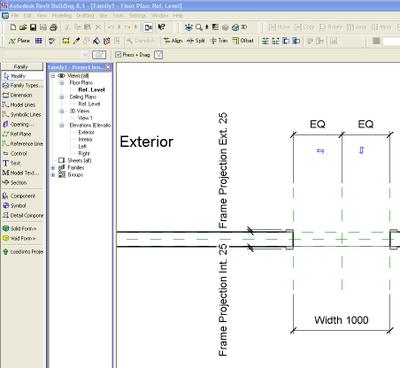Without mastering the “Family Editor” which generally doesn’t feature during “Fundamentals”, you will be even more lost. Every Project is unique, therefore, the need to create unique content to complete successful CD’s is even greater. It’s the complexity to which you create and manage these families, that makes the whole experience unique in it’s own. Prior to R 8.0 the Autodesk Revit Family Editor was very detached from the program. With the new added “Edit Family” Button on the “Options Bar” editing families is now made so much easier
The whole concept behind families is that of building a library, much like blocks. But instead of 3-4 different baths, at different lengths, we can now create 1 bath to suite all. I like to think of it as “one size fits all”…….Parametric. Although Revit does allow you to create families with in the project namely “in Place Families”, I strongly advise against it. Purely, for the reason of, RE-USE. Create the family once and RE_USE over and over. Create with in the project and it becomes project specific, with no way of saving out as yet!
We are currently experiencing the benefits to our extensive library which we started building in 2002, and are still adding to it. It is now a case of just populating the database with components and printing schedules. All the information is stored with in the family needed to complete the relevant schedules of data.
I have recently covered the standard UI for Revit. Now we tackle the “Family Editor” UI.
Upon creating a new Family, Revit first of all asks to which supplied template would you like to categorize the new family. These templates are all individually laid out with all the necessary start up kits pertaining to that specific model/category. Choosing the correct family template is crucial to the start of a new life. Having said that, don’t be concerned though if you have created the family under the incorrect category, it can be changed and this will be covered at a later stage.
You will notice first of all that the “Design Bar” looses all it’s tools and is replaced by the “Family Editor Design Bar”. In it you will find all the necessary tools to create your new Family. The tools available differ from template to template.

The biggest issue we had to deal with, after converting to Revit, is of course, all the cad symbols, “blocks” we had collected over the last 12 years of Autocad – “Legacy Data”. Especially, the symbols provided by manufactures that we used to filling our drawings with. We place the block that actually represents the plan representation of the fixture we intend to specify (this also defines a unique look to our drawings). For example, we have over 30 basins/vanity’s to depict the correct specification. So to keep with-in our office standards, we had to transfer all this legacy data. (fortunately we had students that I trained up to do this for us). In the Following exercise we will be covering exactly that.
How to, “REVITIZE” your current library from "Legacy Data".
Alternatively you pay money for a Revit implementation specialist to come and help.





